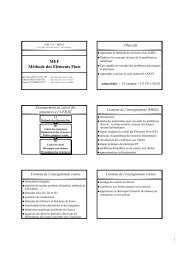Mécanique non linéaire - LMEE
Mécanique non linéaire - LMEE
Mécanique non linéaire - LMEE
Create successful ePaper yourself
Turn your PDF publications into a flip-book with our unique Google optimized e-Paper software.
Comput Mech (2007) 40:1053–1060<br />
DOI 10.1007/s00466-007-0163-0<br />
ORIGINAL PAPER<br />
A material-independent algorithm for preserving of the orientation<br />
of the spatial basis attached to deforming medium<br />
François Peyraut · Zhi-Qiang Feng · Nadia Labed<br />
Received: 6 October 2006 / Accepted: 18 January 2007 / Published online: 15 February 2007<br />
© Springer-Verlag 2007<br />
Abstract The aim of the paper is to propose an<br />
algorithm to satisfy the orientation-preserving condition<br />
with hyperelastic materials. This algorithm is shown to<br />
be applicable for many material models. Its efficiency is<br />
assessed by numerical examples involving the Blatz–Ko,<br />
the Ogden and the Gent models.<br />
Keywords Orientation-preserving condition · Finite<br />
element analysis · Compressible hyperelasticity<br />
1 Introduction<br />
Many industrial applications are concerned by foamlike<br />
or rubber-like materials. The tire technology is for<br />
example one of the main application fields of rubber-like<br />
shells. Such materials are also used to improve the performance<br />
of safety glass by using interlayers to join the<br />
splinters in the case of a crash [4]. Another application<br />
for the automotive industry is the use of polyurethane<br />
foams for a better comfort of car seats [18]. All these<br />
F. Peyraut<br />
LERMPS, Université de Technologie de Belfort-Montbéliard,<br />
90010 Belfort, France<br />
e-mail: francois.peyraut@utbm.fr<br />
Z.-Q. Feng (B)<br />
Laboratoire de <strong>Mécanique</strong> d’Evry,<br />
Université d’Evry-Val d’Essonne,<br />
40 rue du Pelvoux, 91020 Evry, France<br />
e-mail: feng@iup.univ-evry.fr<br />
N. Labed<br />
Laboratoire Mécatronique3M,<br />
Université de Technologie de Belfort-Montbéliard,<br />
90010 Belfort, France<br />
e-mail: nadia.labed@utbm.fr<br />
materials are highly <strong>non</strong> linear and require specific and<br />
robust techniques to perform numerical computation.<br />
In the last decades, many attempts have been made to<br />
solve <strong>non</strong> linear problems, including hyperelastic materials,<br />
with the finite element method. A very detailed<br />
review on the finite element formulation for <strong>non</strong> linear<br />
analysis, including two and three dimensional problems<br />
and involving isotropic, orthotropic, rubber-like<br />
and elasto-plastic materials, has been provided by Sussman<br />
and Bathe [21]. But some numerical topics related<br />
to the compressible hyperelasticity are still questionable.<br />
For example, in the case of the Blatz–Ko material,<br />
the loss of ellipticity leads to numerical problems near<br />
the breaking loading values [14]. More generally, existence<br />
and uniqueness of the solution can be discussed<br />
on the issue of ellipticity, polyconvexity and convexity<br />
of the energy density required to model the material<br />
behavior [3,10,20]. Moreover, it has been proven that<br />
the Newton–Raphson algorithm diverges if the orientation-preserving<br />
condition is not satisfied [15]. To prevent<br />
divergence in case of an orientation-preserving loss, an<br />
algorithm based on the eigenvalues of the deformation<br />
gradient has been proposed by the authors [16]. By using<br />
eigenvalues instead of the determinant, this algorithm<br />
can deal with any geometrical case (volume, area or<br />
line) while the classical condition based on the determinant<br />
only works for preserving volumes. By considering<br />
the Blatz–Ko hyperelastic model [2], this algorithm<br />
has already been found efficient for various geometrical<br />
cases, boundary conditions and applied loads [13,15].<br />
The aim of this paper is to establish the fact that this<br />
algorithm, previously applied to the single case of the<br />
Blatz–Ko hyperelastic model, is indeed efficient for any<br />
kind of behavior laws. We actually prove its independency<br />
on material models because it is found to be free of




